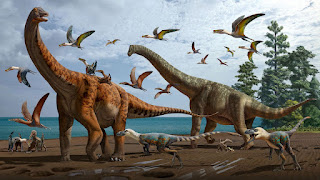
Dinosaurs are a type of reptile that has existed on Earth for approximately 245 million years.
Sir Richard Owen, an English naturalist, coined the term Dinosauria in 1842, derived from the Greek deinos, which means “fearfully great,” and sauros, which means “lizard.”
Fossils of dinosaurs have been discovered on all seven continents.
All non-avian dinosaurs became extinct approximately 66 million years ago.
There are approximately 700 known extinct dinosaur species.
Because they share a common ancestor with non-avian dinosaurs, modern birds are a type of dinosaur.
Paleontologists are like detectives who investigate the evidence left behind by extinct animals. Fossils—the ancient remains of an organism, such as teeth, bone, or shell—or evidence of animal activity, such as footprints and trackways, contain clues to what dinosaurs were like.
All of our knowledge of non-avian dinosaurs comes from fossils, which include bones, teeth, footprints, tracks, eggs, and skin impressions. People all over the world have been discovering amazing fossilized bones and footprints for centuries. Early discoveries sparked legends and fairy tales, with people believing the bones belonged to giants or huge monsters.
Barnum Brown, who began his career at the American Museum of Natural History in 1897, is regarded by some as one of the greatest dinosaur hunters of the late nineteenth and early twentieth centuries. In 1897, he began his career at the American Museum of Natural History. Many of his most important discoveries, including the first Tyrannosaurus rex specimens ever discovered, are on display in the Museum’s dinosaur halls.
Paleontologists now use new technologies to solve unanswered questions about dinosaurs and other fossils, in addition to patience and keen observation skills. CT scans, for example, enable paleontologists to see the three-dimensional structure of fossils without having to remove the matrix.
Paleontologists incorporate biomechanics research, using physics and engineering principles to reconstruct the biological movement of non-avian dinosaurs. Scientists can model how non-avian dinosaurs may have moved using information from fossil bones as well as observations of the movement and musculature of living animal species.
During the Triassic Period, the first known dinosaurs appeared (approximately 250 to 200 million ago). Dinosaurs evolved into a diverse group of animals with a wide range of physical characteristics, including modern birds.
Contrary to popular belief, dinosaurs did not all live during the same geological period. Stegosaurus, for example, lived around 150 million years ago during the Late Jurassic Period. Tyrannosaurus rex lived around 72 million years ago, during the Late Cretaceous Period. Stegosaurus had been extinct for 66 million years before Tyrannosaurus walked the Earth’s surface.
During the Mesozoic Era (more than 180 million years, including the Triassic, Jurassic, and Cretaceous periods), a non-avian dinosaur evolved into an avian dinosaur. This avian dinosaur was the first bird and forerunner to all other birds. Non-avian dinosaurs became extinct 66 million years ago.
There are several hypotheses as to what caused the mass extinction of non-avian dinosaurs and other species at the end of the Cretaceous Period. It is almost certain that a massive asteroid or comet collided with Earth during this time period, causing a dramatic shift in the Earth’s climate. Some scientists believe that this impact had catastrophic effects on Earth’s life. Other factors, such as rising sea levels and large-scale volcanic activity, may have also played a role in this mass extinction.
Paleontologists use fossil evidence preserved in ancient rock to learn about the lives and behaviors of long-extinct animals.
In most cases, a fossilized bone is a mineralized rock with no trace of the original bone material.
The discovery of dinosaur eggs and nests provided evidence for some dinosaur behavior.
Paleontologists can learn about the growth of some dinosaurs by comparing the skulls of Protoceratops of different ages (as shown in the image above).
Paleontologists look for clues preserved in ancient rocks to learn about ancient organisms’ lives, such as fossilized bones, teeth, eggs, footprints, teeth marks, leaves, and even dung.
Jaws, teeth, and dung provide important information about what non-avian dinosaurs ate.
Trackways, or series of fossilized footprints, reveal some intriguing evidence about dinosaur behavior and locomotion.
Until recently, feathers were thought to be unique to birds. Recent discoveries, on the other hand, have revealed evidence for feathered non-avian dinosaurs.
Paleontologists searching for dinosaur fossils begin by surveying areas for Mesozoic-era sedimentary rock. Finding the ideal location necessitates experience and a keen eye.
Fieldwork accounts for only a small portion of what paleontologists do. They also work in the lab, where they examine the specimens they’ve discovered as well as fossils collected years ago. They devote a significant amount of time to classifying specimens, examining their characteristics, and determining biological relationships.
Tyrannosaurus and other theropod dinosaurs had teeth that were pointed, slightly curved backwards, and serrated. The serrations helped slice the meat by catching and tearing muscle fibers as the sharp points pierced it. Meat eaters ate whole chunks of meat rather than chopping or grinding it.
Plant-eating dinosaurs had teeth of various shapes that were tailored to their diets. For example, Triceratops had hundreds of teeth that formed a solid “wall” with sharp ridges. The teeth were used to cut vegetation off. Anatotitan and other plant eaters had wide flat teeth that they used to grind up tough vegetation. Long-necked dinosaurs, such as Diplodocus, had long pencil-like teeth for raking leaves off branches. The dinosaurs ate the leaves whole. They also ingested small stones known as gastroliths, which were most likely used to grind up food in their stomachs, much like modern birds such as parakeets and chickens do today.
Scientists can estimate the height of a dinosaur based on a single footprint. Multiplying the print length by four yields a rough estimate of leg length.
A footprint can also reveal information about the type of dinosaur that left it. A three-toed, sharp-clawed footprint indicates that the creator was most likely a theropod—typically a carnivore. A three-toed print with rounded toes belonged to an ornithopod dinosaur, which was a herbivore. And pairs of unequal-sized prints were most likely created by sauropods, a group of herbivorous dinosaurs with four legs, long necks, and long tails.
Avian dinosaurs, or modern birds, have skeletal features that are nearly identical to some non-avian dinosaurs.
Feathers evolved before flight and could have served as insulation to keep dinosaurs warm or as a means of display to attract mates.









